After the success of its co-branding with Duerr’s to extend its offering to peanut butter, Kellogg’s is now seeking to repeat this with another partner. As a marketing agent group, you have been consulted by Kellogg’s
ASSIGNMENT 1 - Marketing Management 2021: Group Presentation.
Developing the brand with ‘co-branding’.
Marketing management starts with two of the most important topics in modern marketing, STP [Segmentation, Targeting, and Positioning] and Branding. This assignment aims to test your understanding of these two topics in addition to a third topic, IMC [Integrated Marketing Communications].
The assignment will give you the opportunity to use your imagination and creativity, work professionally and apply marketing theory to a ‘real organisation’. This is a group presentation; you will notice that you have been divided into groups (A, B, C and D) you will need to work on this assignment with your allocated group mates.
Submission date: Live presentations through MS Teams during your seminar session in w/c 29/03/2021
The Scenario:
Kellogg’s is an American multinational food company. It is one of the leading food manufacturers in the world. For more than 100 years, Kellogg’s provided consumers with a wide variety of food products ranging from snacks to breakfast to frozen food. The Kellogg’s brand is guided by the company’s ethical practices and value-based culture. In 2019 it was rated in the top 5 most valuable food brands and in 2020, it was ranked in the top 100 for the World’s most ethical companies, the world’s best employer, best employers for women, and most trusted brands (for more see here).
Kellogg’s strategies focus on engaging with its stakeholders to ensure their needs are being met. For Kellogg’s, this means ensuring the highest ethical standards and sustainable business practices. Kellogg’s has a Global Code of Ethics governing how it deals with stakeholders across the world. Kellogg’s vision and core purpose outline what the company wants to achieve. They guide the organization’s decision-making processes to help meet the expectations of its stakeholders. Kellogg’s vision sets out the company’s main aim: ‘A good and just world where people are not just fed but fulfilled. This is supported by Kellogg’s purpose of “Creating better days and a place at the table for everyone through our trusted food brands. We are a company of promise and possibilities. Each day represents a fresh opportunity to share Our Vision, live Our Purpose. By being mindful and committed to these ideals, we uphold our founder’s dedication to people and their well-being. And we promote an environment where we can push beyond boundaries and across borders to create foods and brands that help to fuel the best in everyone everywhere.” (Kellogg’s 2021).
Kellogg’s entered the UK market in 1922 with only two products; Kellogg’s Corn Flakes and All Bran. Now it offers a much wider range of products through its 17 different sub-brands (for the full timeline of Kellogg’s in the UK, please see appendix A). Every and each one of those sub-brands is guided by Kellogg’s vision and mission and framed by the brand values. Each sub-brand represents a group of products which hold different benefits and aimed to different segments. Those are:
- All-Bran
- Bran Flakes
- Fruit n’ Fiber
- Sultana Bran
- Coco Pops
- Crunchy Nut
- Frosties
- Kellogg’s
- Kellogg’s Corn Flakes
- Krave
- Nutri Grain
- Pop Tarts
- Rice Krispies
- Rice Krispies Squares
- Special K
- W. K. Kellogg’s
- W. K. Kellogg’s by kids
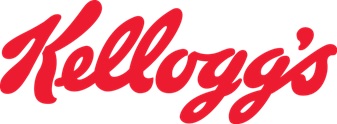
The challenge:
The main challenge for any business nowadays -no matter how big or small, strong or weak, successful or not is dealing with the change of demand and consumer behaviour due to Covid-19 pandemic. A sudden alteration to what people consume and how they consume products and services lead to thousands of UK businesses to face a catastrophic failure (Financial times 2020). On the contrary, for some business, covid-19 pandemic held an opportunity for growth. Some products naturally enjoyed an increase of demand due to their functional benefits in relation to the pandemic, such as toilet papers, hand sanitisers, detergent products, and anti-bacterial handwash.
Online service providers also benefited massively from the pandemic, such as Amazon, Microsoft Teams and Netflix who experienced an exceptional growth in profit. However, for other business, the options were either to adjust the business model to fit within the change of habits (such as universities and the move to online/blended teaching) or try to cut cost and minimize the organisation size to lessen the negative impact (such as airlines and travel and holiday agencies).
For breakfast eating, the consumer behaviour also got affected by the pandemic. A research by food analyst Richard Caines published on Mintel (2020) found that customer’s attitude towards eating breakfast has sifted towards more appreciation of having a healthy breakfast that would boost the immune system (figure 1). The research further found that customers perception of breakfast quality has also been affected. Surprisingly, customers during the pandemic became more demanding to a quick and easy to prepare breakfast that can help to feel full for longer and high in fibre (figure 2). Sales of sweet and nut spreads, as well as marmite, have been boosted by the covid-19 pandemic and people spending time at home, including eating breakfast at home more frequently (i.e. more toppings on toast). Peanut butter has been gaining share in breakfast spreads. Some sweet spreads such as jams and peanut butter have also benefited from being used in home baking (Mintel 2020).
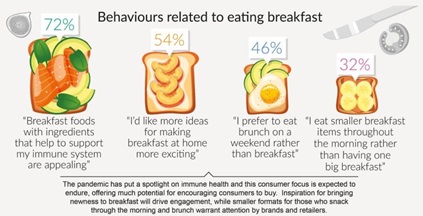
Figure (1): change of breakfast eating habits due to impact from covid-19 pandemic. Source: Mintel (2020
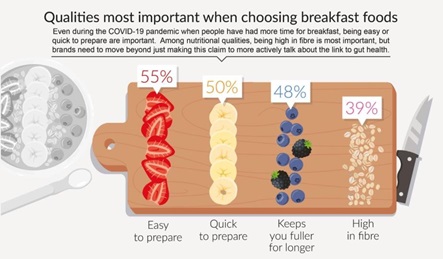
Figure (2): Most important benefits from breakfast during the pandemic. Source: Mintel (2020)
Kellogg’s saw the opportunity streaming out of the change in customer’s behaviour towards breakfast. The brand benefited from its strong brand position and brand awareness and sustained a slight but steady growth in revenue. However, to take the most out of the opportunity, Kellogg’s designed a co-branding strategy by extending its Crunchy Nut brand into peanut butter in July 2020. Its move was in partnership (co-branding) with peanut butter manufacturer Duerr’s to combine “two breakfast favourites” which aimed to benefit both brands and appeal to a wider customer segment that consist of new and existing customers of both brands (See Appendix B, Kellogg’s 2020). This followed similar strategies by competitors such as Mars’ move into peanut butter with its M&M’s and Snickers brands in 2020.
Kellogg’s has so far managed to successfully face the changes placed by the pandemic; customer’s breakfast eating habits seem to be positive towards healthy breakfast products. However, during pandemics or other crises, customers tend to save their money and seek cheaper alternatives, but for Kellogg’s things seem to be going well so far, and the brand has managed to benefit more with its co-branding strategy with Duerr’s. Now with the vaccine is becoming widely available, it is expected that the high demand for cereals from more breakfast at home will gradually decline as children return to school and as more people return to the workplace (Mintel 2020). Hence, brands’ current focus is on seeking new response strategies to keep their customers, sustain growth and retain profit.
The task:
After the success of its co-branding with Duerr’s to extend its offering to peanut butter, Kellogg’s is now seeking to repeat this with another partner. As a marketing agent group, you have been consulted by Kellogg’s to select an appropriate (sub-brand) from Kellogg’s product groups and select a partner brand from the outside of the Kellogg’s groups (sub-brand) to develop a product-based co-branding strategy. According to Jobber and Ellis-Chadwick (2013:331) “product-based co-branding involves the linking of two or more existing brands from different companies or business units to form a product in which the brand names are visible to consumers”. For example, Haagen-Dazs ice cream combined with Bailey’s liqueur to form Haagen-Dazs with Baileys flavour ice cream is another example of co-branding (Jobber and Ellis-Chadwick 2013).
As part of the co-branding strategy you must select a brand of your choice to link to your Kellogg’s sub-brand. You must have a strong justification for linking the two brands based on appropriate secondary research (macro PESTEL and micro 5 Forces environmental analysis). You must review the existing Kellogg’s sub-brand and use the concepts of branding and promotional mix to successfully develop a co-branding strategy. This will require you to consider the STP of your new recommended product (co-brand). You need to prepare a group presentation to present your findings (see below for the specific requirements)
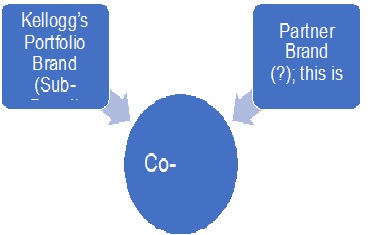
The presentation will need to clearly identify the target market (using STP), and how this differs from the current market. The new promotional mix of the co-brand also requires clarifying including, new media, new message and new brand position.
The group presentation is PowerPoint based. You will present on MS teams during the session of week commencing 29th of March 2021. Your seminar tutor who will assess your presentation will be recording it for moderation purpose. Your presentation will last no longer than 20 minutes. You will be asked to stop the presentation if it exceeds 20 minutes. In addition, you must submit an electronic copy of your presentation slides to Dropbox along with group presentation paperwork (i.e. peer assessment forms + group meeting minutes + Collaborative working agreement) – please read the submission guidelines below.
Presentation Structure: [this is only a guide]
- Cover slide (one slide)
- Title
- List of names with student number.
- Your seminar number and seminar tutor name
- Introduction (1-2 slides)
- Overview of your co-brand strategy
- Key rationale
- Background on the brand(s) (as many slides as needed) to highlight key external factors from MACRO/MICRO and key internal factors linked through SWOT analysis.
- Customer analysis for the current target market(s).
- Competitor analysis.
- Key opportunities/justification
- Detail the recommended ‘co-brand’ strategy (as many slides as needed) Consider:
- STP (Segmentation Targeting Positioning)
- Branding details
- Promotional mix [IMC]
- Summarise the key points of the co-branding strategy
- All materials used must be referenced in Harvard referencing style
· Conclusion
· References
Submission Guidelines:
Before your presentation, all of the below documents must be submitted on or before Sunday 28/03/2021 11pm:
One assigned member from the group must submit all of the followings to Dropbox:
- An electronic copy of the group presentation slides
- Collaborative Working Agreement identifying the group’s mutually agreed approach of working includingassigned roles (coordinator, shaper, team worker…etc.)
- Group Work Meeting Minutes: a record of attendance at all meetings and notes of actions allocated to individuals (use the Meetings Record template)
- Individual Peer Assessment Form: An electronic copy of your own Group Project Peer Assessment Form
All members of the group (including the one who submitted the above to Dropbox) Individually submit:
Templates of all documents mentioned above will be available on NOW
Deadlines are important and must be strictly adhered to. You must submit on or before Sunday 28/03/2021 11pm. All presentations will take place during the seminars of week commencing 29/03/2021
How you will receive feedback
Feedback on your coursework will be returned to you electronically to the same Dropbox folder as for the submission and using the NBS Student Feedback Form. This will include all the feedback from your tutor about your assignment and your tutor will NOT return an annotated copy of your coursework.
A major benefit of submission and return of feedback through the Dropbox is that you will be able to access your feedback in your Student Dashboard (by navigating to the Assessments Tab from your profile page) and without having to navigate to separate Learning Room Drop boxes.
Where to Start? IMPORTANT please read!
Groups have already been allocated, please make sure you know which group you’re in (A, B, C or D). Failure to attend seminar sessions and engage with the module will highly affect the quality of your work and contribution towards your group work. Contact your tutor as soon as possible if you have any concerns.
You may start by agreeing on teamwork and finding the best way to collaborate. For example, you may create a MS Teams channel for your group, or a shared document in which each member and remotely add and contribute to…etc.
In terms of the task:
Firstly, groups should select and agree on a Kellogg’s brand (sub-brand) from the list on the previous page (scenario above). Think carefully before you decide on your portfolio brand (sub-brand) as you will need to make sure you can source appropriate secondary research to justify your selection.
Secondly, groups should select a suitable/appropriate brand (partner brand) to form the basis for your co-brand. Your partner brand must be outside the Kellogg’s portfolio brands (sub-brand) and brainstorm on what the new product can be – see Appendix B for an example.
Remember, you will need to justify why you have selected the sub-brand and partner-brand as this will provide a strong co-branding strategy. Justification will be based on detailed secondary research; therefore, you should spend some time researching and rationalising your brands
Appendix A: Kellogg`s UK History Timeline
|
1889
|
In a failed attempt at making granola to feed patients at their health sanatorium in rural Mid- West America, our company’s founder, William Keith Kellogg, and his brother, Dr John Harvey Kellogg, changed breakfast forever when they accidently flaked wheat berries. W.K kept experimenting until he flaked corn, and created the delicious recipe for Kellogg’s Corn Flakes.
|
|
1906
|
W. K. Kellogg opened the “Battle Creek Toasted Corn Flake Company” in Battle Creek, Michigan, in the United States of America and hired his first 44 employees. Together they created the initial batch of Kellogg’s Corn Flakes and brought life to W.K’s vision for great- tasting, better for you breakfast foods.
|
|
1916
|
Kellogg’s launches its second cereal – All-Bran.
|
|
1922
|
Kellogg’s arrived in the UK in 1922. Kellogg’s Corn Flakes and All Bran were the first introduced to the British Public, imported originally from the USA and later from Canada.
|
|
1923
|
In 1923 Kellogg’s hired the industry’s first dietitian to provide consumers with information about nutrition.
|
|
1924
|
An office for the Kellogg Company of Great Britain opened in Holborn, London in 1924.
|
|
1925
|
From 1925, a decade of hard work by a sales force of 15 men covering the whole of the United Kingdom, helped convert the British, who were then suspicious of dietary innovation, to the ‘ready-to-eat’ cereal breakfast.
Millions of sample packets of cereal were distributed door to door.
|
|
1928
|
Kellogg’s introduces Rice Krispies to Britain.
|
|
1934
|
Harry McEvoy is appointed as Managing Director of Kellogg’s in the UK. Harry continued to lead Kellogg’s in Britain for more than 30 years and is credited with helping to establish Kellogg’s as a household name.
|
|
1938
|
Strong sales meant the time was right to open a factory in Britain to supply the UK and Continental Markets.
Kellogg’s opened its first British factory in Trafford Park, Manchester, on 24th May 1938. The Head office also moved from London to Manchester. The factory cost $2 million to build and covered 130,000 square feet. The factory was situated within a 75 mile radius of the highest population density in the country (great for customer base and workforce). It also had great road and rail links and Manchester ship canal for transportation.
Kellogg’s ran a competition to find Britain’s typical housewife – won by Florence Millward –
to officially open the factory.
|
|
1941
|
During World War Two Kellogg’s had its own unit of the home guard and workers from the plant would do their duty as part of the Air Raid Precaution and Area Ambulance Unit after their shifts. Rationing meant that Kellogg’s food could only be sold in the UK Midlands, North of England and Scotland. Corn Flakes were temporarily replaced by wheat flakes made of British grown crops due to food import restrictions.
|
|
1950
|
In the early 50’s Kellogg’s ran its first press ad directly targeting the people of Manchester.
|
|
1951
|
William Keith Kellogg died at the age of 91 in Battle Creek, Michigan, on 6th October. He entailed the bulk of his fortune to the WK Kellogg Foundation, which he had helped to establish two decades earlier, to improve the lives of children across the world. Today, the WK Kellogg Foundation remains the largest single shareholder in the Kellogg Company.
|
|
1954
|
Kellogg’s Sugar Frosted Flakes (Frosties) were introduced to Britain in 1954. These were the first cereal of the sugar coated type to reach the market.
It achieved instant success, attaining a level of £1 million sales in its first year. Frosties’ Tony the Tiger has been voted as one of the top 10 brand icons of all time.
|
|
1956
|
Kellogg’s launches Special K into the UK. It was originally designed as a high-protein breakfast cereal aimed at men.
|
|
1960
|
Coco Krispies (Coco Pops) were introduced to Britain in 1960 and were supported by a substantial T.V. advertising campaign.
|
|
1963
|
Prince Phillip visited the Trafford Park factory in 1963. He was met by Florence Millward who was invited back 25 years after she opened the factory.
|
|
1969
|
The Kellogg Company was honoured to provide breakfast for the legendary Neil Armstrong, Buzz Aldrin and Michael Collins during their ground breaking Apollo 11 trip to the moon.
|
|
1970
|
In 1970 Jonathan Ross starred in a Rice Krispies ad.
|
|
1974
|
Prince Charles visited the Trafford Park factory in 1963.
|
|
1978
|
Kellogg’s opened its second UK factory – in Wrexham in North Wales. The site was officially opened by HRH Princess Alexandra on 28th April 1978.
|
|
1980
|
Crunchy Nut Corn Flakes were launched in the UK in 1980.
|
|
1982
|
Prime minister Margaret Thatcher visited the Kellogg’s Manchester factory in 1982 and received a toy Tony the Tiger from Kellogg’s UK Chairman, Ross Buckland. Some workers downed their tools and walked out in protest.
|
|
1984
|
Fruit and Fibre was launched in the UK in 1984.
|
|
1984
|
British Olympic Athlete Steve Cram visited the factory to launch Start in 1984.
|
|
1998
|
Kellogg’s started to support school breakfast clubs across in Britain. Since 1998, Kellogg’s has provided 70 million breakfasts, trained 1,600 schools, and provided £4 million of investment so schools can provide the best start to the day for thousands of children.
|
|
2010
|
To help people reduce the amount of salt in their diet, Kellogg’s took 30% of salt out of family favourite cereals like Corn Flakes and Rice Krispies. In 2010 Kellogg’s cereals had 50% less salt than they did a decade ago.
|
|
2011
|
Kellogg’s announces it will add vitamin D to all of its kid’s cereals to help combat the rise of rickets in 2011.
|
|
2012
|
In 2012 Kellogg’s acquired Pringles – becoming the second biggest savoury snacks company in the UK and the world.
|
|
2013
|
Kellogg’s launched its Breakfasts for Better Days initiative in 2013 and pledged to donate 15 million breakfasts and snacks to people in need by the end of 2016.
|
|
2016
|
Kellogg’s filmed an episode of Inside the Factory for the BBC with Greg Wallace and Cherry Healey which was broadcasted in 2016.
|
|
2017
|
In 2017 Kellogg’s announced a significant overhaul of its cereals to help the people of Britain make healthier choices in the morning.
This included reducing sugar in Coco Pops by 40%, dropping sugar in Rice Krispies by 20% and by 30% in Rice Krispies Multigrain. Kellogg’s also removed high-sugar Ricicles from sale.
|
|
2018
|
Kellogg’s enter the organic and vegan foods market with the launch of a new W.K. Kellogg plant-based cereals in 2018. The cereal – named about our company’s founder – committed to donating a portion of cash generated by sales to good causes. Kellogg’s adopts colour-coded traffic light front of pack labelling on its cereals sold in Britain.
|
|
2019
|
Kellogg’s announced the largest ever redesign of its iconic cereal packs. Kellogg’s is also recognised as the most trusted food and drink company in the UK (Source: Reputation Institute).
|
Source: Kellogg’s the company website 2021
Appendix B: Kellogg partners with Duerr’s to launch crunchy nut peanut butter
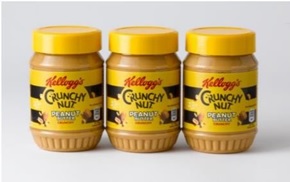
With the peanut butter market currently estimated to be worth £104m² and the retail sales value of Crunchy Nut standing at over £100m³, Kellogg and Duerr’s identified a window to innovate together. For Kellogg, the new launch provides an opportunity to penetrate a wider range of occasions with Crunchy Nut, in addition to breakfast.
Peanut butter can currently be found in 42% of households across the UK and the numbers continue to rise year on year.Showing a similar level of saturation, Kellogg’s Crunchy Nut holds the title as the UK’s favourite breakfast cereal and during the lockdown period the business saw a year on year sales increase of 43%.
Commenting on the new launch, Ben Simpson, Revenue & Channel Director at Kellogg’s UK said: ‘’Crunchy Nut is regularly hailed as the UK’s favourite cereal and we have seen huge sales increases over the last few months, with more shoppers having breakfast at home.‘’
Knowing the popularity of the cereal, launching Crunchy Nut Peanut Butter allows us to meet a wider range of
consumer occasions and it’s been great to work with another Manchester based business in Duerr’s to make that possible. With recent data revealing peanut butter sales have overtaken jam, we’re confident that the launch of Crunchy Nut Peanut Butter will prove to be a popular one.’’
Richard Duerr, Sales and Marketing Director at Duerr’s, commented: “The peanut butter category is a huge area of growth, with sales currently booming. We’re extremely proud to have teamed up with another Manchester giant to create this exciting product that marries together two hugely popular breakfast staples to create the ultimate treat.”
Source:
https://www.kelloggs.co.uk/content/dam/europe/kelloggs_gb/pdf/Crunchy_Nut_Peanut_Butter_Launch.pdf
100% Plagiarism Free & Custom Written,
tailored to your instructions